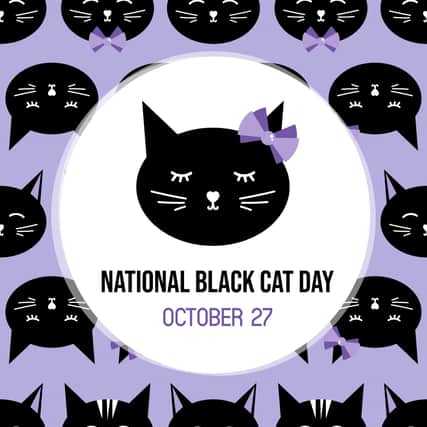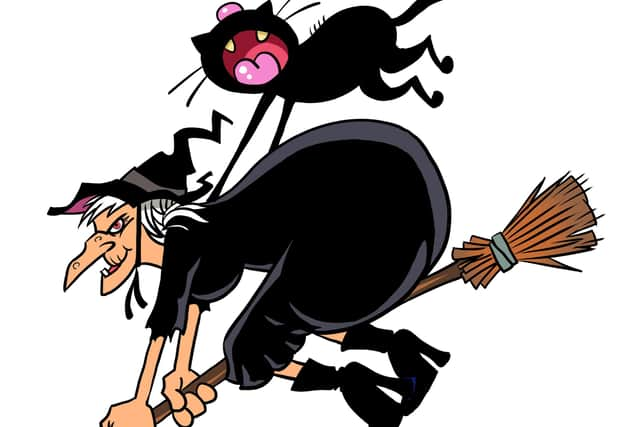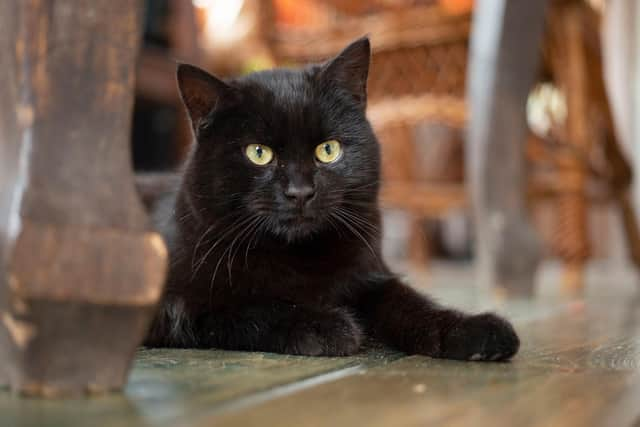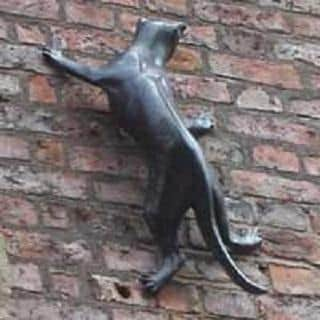Stating the case for dark felines as treasured pets – National Black Cat Day


As Halloween approaches, It’s a sad fact that black cats are the least likely animals to be adopted and the most likely ones to be abandoned, writes Steve Cain.
On average they wait 22 per cent longer to be rehomed than their more colourful cousins.
There are a variety of reasons why this is the case.


Advertisement
Hide AdAdvertisement
Hide AdThese range from their past association with witches and the occult to the fact that they don’t look good in selfies and also in photographs.
Some people also prefer tortoiseshell cats and tabby and ginger cats because of their distinctive markings, which are perceived to make them more attractive.
The poor black cat cannot compete with patterned cats.
It has no coloured nose, no stripes and no markings.


However, a black cat is likely to be as loving a pet as any other.
And there are many black cats out there who still need to find their forever homes.
Advertisement
Hide AdAdvertisement
Hide AdBlack cats are the result of genetic mutation which affects pigment-producing cells.
This mutation in black cats also occurs in wild cats and the cat we call a panther is not actually a separate species, but it is rather a black jaguar or leopard.


In the right light, the underlying spots of these cats are clearly visible.
The genetic mutation that is responsible for making a cat black is also believed to make them more resistant to diseases, which include Feline Immunodeficiency Virus.
Advertisement
Hide AdAdvertisement
Hide AdResearch is also continuing to establish this theory as fact.
Just as genetics play a role in the colour of cats' fur, it is also responsible for the colour of cats' eyes.
The same pigment that affects black cats' fur also affects their irises.
The majority of black cats have irises with yellow/gold, orange/copper or green pigment.
Advertisement
Hide AdAdvertisement
Hide AdThe Bombay Cat is a breed that typically has eyes in the gold or copper range. Black cats in other breeds are more likely to have lighter eyes.
The black cat has been one of the most famous creatures in superstition for many centuries, crossing your path leading the list as the world’s most famous bad luck symbol.
Although, among one of the most striking inconsistencies to be found in the annals of superstition, the reverse is said to be true here in the UK and Japan.
It’s a bit more complicated in Germany, depending on the direction in which the cat crosses.
Advertisement
Hide AdAdvertisement
Hide AdFrom left to right is a good omen but, from right to left, then you’d better watch out!
In Scotland a black cat on the doorstep indicates future prosperity, whereas in China it signifies poverty and famine.
In York there are at least 23 statuettes of black cats to be found on walls, chimney pots and roofs.
The history of the cats in York dates back to 1920, when Sir Stephen Aitcheson placed two on a building he owned in Low Ousegate.
Advertisement
Hide AdAdvertisement
Hide AdSome say he put them there to scare away rats and mice but it’s more likely he thought they would be eye-catchingly attractive.
Others followed his idea and other black cats began appearing around the city in the hope that good things would happen.
Some 19th century pirates believed, if a black cat walked towards them, they would experience bad luck.
But, if it walked away from them, their fortunes would take a turn for the better.
Advertisement
Hide AdAdvertisement
Hide AdIf a black cat walked onto a ship and then off again, it was thought the ship was doomed to sink.
Many people dislike black cats because their colour is reminiscent of night and the powers of darkness.
A sinister-looking nocturnal animal by nature, it has been considered a consort of evil spirits – witches in particular – since the very earliest of times.
The belief that witches transformed themselves into black cats may stem from a 16th century Lincolnshire legend.
Advertisement
Hide AdAdvertisement
Hide AdReturning home from a tavern one evening, a father and son were startled by a black cat.
They threw stones, injuring the creature, and it retreated to the house of an old woman, suspected of being a witch.
The following day, the same old woman was seen around the village, covered in bruises and walking with a limp.
But, paradoxically, the black cat was revered in some cultures.
Advertisement
Hide AdAdvertisement
Hide AdIn ancient Egypt, keeping a black cat was thought to be a way of winning favour with the goddess Bastet, who protected the home.
She was often depicted with the head of a cat.
The Romans believed black cats to be sacred to the goddess Diana.
King Charles I was said to have owned a beloved black cat that he considered brought him good fortune.
He kept it under guard to ensure its safety. When it finally died, he claimed his luck had left too.
Advertisement
Hide AdAdvertisement
Hide AdThe next day, he was arrested, charged with treason and ultimately executed.
Sir Winston Churchill was a lover of cats.
He adopted a black stray that he named Nelson, after Admiral Nelson.
When Churchill became Prime Minister in 1940, Nelson took up residence in 10 Downing Street, seeing off Neville Chamberlain’s cat, which went next door.
Other famous owners of black cats include Brigitte Bardot, Cher, Bob Dylan, Frank Zappa, Ernest Hemingway, James Dean, Jane Fonda, John Lennon and Yoko Ono as well as Marc Bolan.
Advertisement
Hide AdAdvertisement
Hide AdBlack Cats are also featured as mascots, most notably in the case of Sunderland Athletic Football Club.
The club officially adopted the nickname “The Black Cats” in 2000 after a poll in which 11,000 people agreed.
However, the link goes back much further than that.
In 1905 a black cat was featured in a team photograph and, in 1937, a black kitten sat in the pocket of a young supporter as he watched the FA Cup Final at Wembley Stadium.
Sunderland came back from the brink of defeat to beat Preston 3-1 ... and the association of black cats and Sunderland AFC was cemented.
The coat of arms of Kidwelly in Wales features a black cat.
Advertisement
Hide AdAdvertisement
Hide AdIt is believed the cat comes from “Catwelli,” an alternative spelling of Kidwelly.
Legend also suggests, when the inhabitants of the town first returned after it had been ravaged by the plague, the only living thing left was a single black cat.